Holly Tucker's Blog, page 41
December 30, 2014
Inventing the Scientist
By Laura J. Snyder (Guest Contributor)
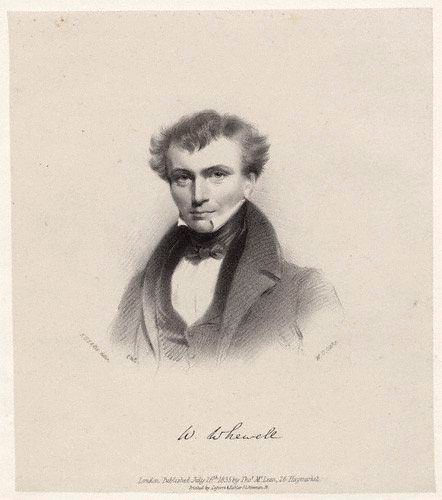
William Whewell
It was June 24, 1833, at the meeting of the recently-founded British Association for the Advancement of Science. William Whewell (pronounced “who-ell”), a fellow of Trinity College, Cambridge, and former professor of Mineralogy, had just finished a speech opening the conference. When the applause died down, the members were shocked to see a frail, grizzled man rise slowly to his feet. Samuel Taylor Coleridge, the celebrated Romantic poet, had written a treatise on scientific method decades before. Coleridge had hardly left his home in Highgate for the past thirty years, yet he had felt obliged to make the journey to attend this meeting.
At that time, the practitioners of science were known primarily as “natural philosophers.” Coleridge remarked acidly that the members of the association should no longer refer to themselves this way. Men digging in fossil pits, or performing experiments with electrical apparatus, hardly fit the definition. They were not, he meant, “armchair philosophers,” pondering the mysteries of the universe, but practical men – with dirty hands, at that. As a “real metaphysician,” he forbade them the use of this honorific.
The hall erupted in a tumultuous din, as the assembled group took offense at the insult Coleridge clearly intended. Then Whewell rose again, quieting the crowd. He courteously agreed with the “distinguished gentleman” that a satisfactory term with which to describe the members of the association was wanting. If “philosophers” is taken to be “too wide and lofty a term,” then, Whewell suggested, “by analogy with artist, we may form scientist.”
It was fitting that the term was invented by Whewell who, along with three of his friends, transformed the natural philosopher into the modern scientist.
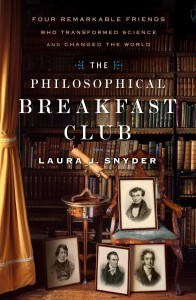 Laura J. Snyder is associate professor of philosophy at St. John’s University, and the author of Reforming Philosophy: A Victorian Debate on Science and Society (University of Chicago, 2006) and The Philosophical Breakfast Club: Four Remarkable Friends who Transformed Science and Changed the World (Broadway, February 22, 2011).
Laura J. Snyder is associate professor of philosophy at St. John’s University, and the author of Reforming Philosophy: A Victorian Debate on Science and Society (University of Chicago, 2006) and The Philosophical Breakfast Club: Four Remarkable Friends who Transformed Science and Changed the World (Broadway, February 22, 2011).
This post was first published on Wonders & Marvels in January 2011.
December 29, 2014
The Giving Season Isn’t Over Yet: Book Giveaways

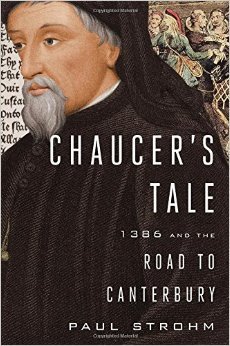 Beginning to feel the post-Holiday blues? Didn’t get that historical tome on your wish list this year? Cheer up!
Beginning to feel the post-Holiday blues? Didn’t get that historical tome on your wish list this year? Cheer up!
The giving continues here at Wonders & Marvels! It is not too late to sign up for our December Book Giveaways featuring two wonderful books from some of our Guest Contributors.
This month we are thrilled to give away Paul Strohm’s Chaucer’s Tale:1386 and the Road to Canterbury which tells the story of the tumultuous year that led to the creation of The Canterbury Tales. To take a peek at what this book holds, read Strohm’s guest post Chaucer’s Room.
We are also excited to have Alexander Watson’s new book Ring of Steel: Germany and Austria-Hungary in World War I to giveaway! Ring of Steel retells the war from the perspectives of its instigators and losers, the Germans and Austro-Hungarians. To see a little bit of the different perspectives, take a look at Watson’s guest post No Appetite for War.
Don’t forget to sign up for a chance to get one of these fascinating new books before 11pm EST on December 31st (your entry includes a subscription to W&M Monthly). Please note that, at this time, we can only ship within the US.
Monthly Book Giveaways
* indicates required
Email Address *
First Name
December Book Giveaways
Paul Strohm, “Chaucer’s Tale:1386 and the Road to Canterbury”
Alexander Watson, “Ring of Steel: Germany and Austria-Hungary in World War I”
December 25, 2014
A Versailles Christmas
By Christine A. Jones (Guest Contributor)
A few years ago I had the pleasure of visiting the Bibliotheca Bodmeriana in Geneva (a must-do for historical bibliophiles), where the eyes feast on marvels such as a full codex of the gospel of John and a Gutenberg Bible. Among the rare court documents that Martin Bodmer collected over his lifetime sits Elizabeth I’s Christmas gift list for her courtiers; names and gifts descend in order of rank. Looking at it, you have a glimpse into Elizabethan holiday ritual. It occurred to me as a French seventeenth-centuryist that I knew little about Noël at Versailles. I turned to the fountainhead of anecdote about the Sun King’s reign: the Duc de Saint-Simon.

Versailles Chapel
Louis XIV’s outspoken courtier talks about the holiday several times in his 15-volume memoires of the court. Two mentions are incidental and occur because another important event he is describing happens to take place around Christmas. A third that briefly details holiday ritual (Chapter LXXI) is tucked into a description of the religious skepticism of Louis XIV’s brother, Monsieur, Le Duc d’Orléans. Saint-Simon sets his story of the prince’s ungodliness at midnight mass in Versailles’ chapel—three midnight masses to be exact—to which Monsieur accompanied the king. The memoires describe the beauty of the atmosphere as charmed, even for Versailles: music that surpassed the opera, magnificent decoration, and extraordinary lighting. Palace celebration, trimming and all, revolved around the mass.
In the midst of this “brilliant scene,” Monsieur sat reading what looked like a prayer book. A lady-in-waiting was moved by the vision of the Duc immersing himself in the spirit of the night and remarked on it. As Saint-Simon recollects it, the Duc responded, “You are very silly, Madame Imbert. Do you know what I was reading? It was ‘Rabelais,’ that I brought with me for fear of being bored.” So much for holy music and fabulous decoration. On Saint-Simon’s read, no manner of divine celebration could stop Monsieur from “playing the impious, and the wag,” not even Christmas at Versailles.
Christine A. Jones teaches French 17th/18th-century literature and culture at the University of Utah. She writes on fairy tales, porcelain, dance and wine.
This post was first published on Wonders & Marvels in December 2011.
December 23, 2014
A Theft of Art
by Jack El-Hai, Wonders & Marvels contributor
We had a ritual, the three of us. We’d swing open the glass doors and inhale the humidified, clean scent of art. I would take the girls’ hands as we climbed the stone steps to the third floor. Then my younger daughter would break away and run through the galleries, snaking between sculptures and unnerving the guards, until she stopped before the object of her adoration. She knew not to stand too close to the painting she loved, Rembrandt’s Lucretia, as she waited for her sister and I to catch up. Her painting was one of the few that had an electronic alarm that detected close movement, a point of pride for her.
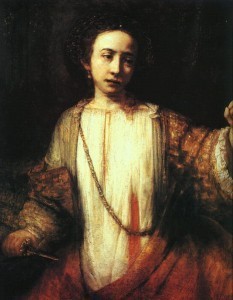
Rembrandt’s Lucretia.
We’d gaze at the painting, a little resentful if anyone else loitered nearby, and she would tell its tale. From an early age, my youngest knew that the historical Lucretia had stabbed herself. Something bad had happened and it pained her to live. Lucretia gazed to the side as she pulled a rope to call a servant and allowed the blood to darken her nightgown. We would stand close together out of respect for this stricken woman. My younger daughter’s story would echo in the gallery before silence settled.
Then would come my older daughter’s turn. Her painting was on the same floor of the museum but far away, beyond a picture of a grimacing monkey burning a cat’s paw and Paul Revere’s silver set and the olive trees by van Gogh. Too old to run, she would speed-walk into her gallery and establish herself in her spot to the left of the painting. She would turn to face us as we entered. It would never fail to startle us to see the close resemblance between my older daughter and the dark-haired girl in On the Thames, A Heron by James Jacques-Joseph Tossot. My older daughter would hang her arms at her side, looking at us, basking in the peculiarity of her likeness to a figure on an old canvas. She shared with the painted girl a deadpan seriousness that could erupt into hilarity at any moment. I would read aloud the museum’s interpretation of the painting posted on the wall, which had something to do with the heron in flight representing a loss of innocence, but this story would make the girls snort with laughter.
My painting was close by, and I’d sometimes head for it while the girls still lingered around Tossot’s picture. It hung in a gallery devoted to expressionist art. Fernand Leger’s Smoke Over Rooftops is a crowded cityscape seen from above, a scene filled with chimneys, windows, and walls. The colors of the rooftops draw me in: I have never seen reds and blues, especially blues, jump out so in any other painting. Though no human figures appear, the picture conveys the complexity and privacy of people’s lives. The buildings hide what’s happening inside, only releasing inscrutable curls of smoke as clues. The girls would come to my side, soberly impressed. We believed Smoke Over Rooftops concealed secrets that would remain shrouded forever.
One day several years ago, we arrived in the expressionist gallery and found the Leger gone. In its place hung another painting, something not memorable. It was as if Sirius had decamped from the night sky, replaced by a smudge. I couldn’t believe the loss of my painting. Pictures typically disappear from museum walls for a variety of reasons — when they undergo restoration, are loaned to other institutions, or go into storage to permit the exhibition of another work, for instance — but I learned that none of these situations caused the removal of Smoke Over Rooftops. A crime had made it happen.
In 1940, this painting had been the property of a French collector named Alphonse Kann, who had inspired the character Charles Swann in Proust’s Remembrance of Things Past. When the Germans occupied Paris, they stole the painting, along with 1,201 additional artworks that Kann owned as well as tens of thousands of paintings and sculptures from the homes of other Jews. Kann escaped France and died soon after the war. Trapped in a new black market of stolen art, the painting passed through many hands. A businessman unaware of its provenance bought Smoke Over Rooftops in New York City during the 1950s and donated it to our museum. Fifty years after Kann’s death, his descendants tracked it down to our institution’s collection. It took ten years for the Kann heirs and the museum to untangle the threads of theft and ownership, but finally, with no advance notice to the public, the painting returned to the Kann family.
One family’s property had been restored, but where did that leave my family’s ritual? I explained to the girls about the theft of art during the Holocaust and the complicated disputes over rightful ownership, but I could not answer all of their questions: Should we feel bad to have enjoyed a stolen painting? Why couldn’t the Kann family share the painting with the museum and allow people like us to keep seeing it? Was it wrong for us to have acted as though we owned the painting? After the painting’s removal, our visits to the museum seemed incomplete when our thoughts, if not our footsteps, led us to a gallery whose most captivating work was missing.
Our pilgrimages to the museum have continued. My younger daughter no longer takes off, a little blonde streak, when we near Lucretia — we all arrive together at Rembrandt’s gallery. The group arrival is appropriately protective, because my daughter has learned that Lucretia’s woes grow out of her rape by the son of a Roman king. My older daughter refuses to pose next to On the Thames, especially with other people standing nearby, and her maturing face looks less like that of the girl in the frame. My daughters have grown.
I’m the one who has failed to adjust to the new circumstances in the galleries. I haven’t found a new favorite, despite the efforts of the girls to sell me on a spectacular 19th century painting of an Egyptian rug merchant by Jean-Léon Gérome. I like it, but I’m afraid to draw it into our family ritual. It too could prove to be stolen goods. It too could disappear.
Further reading:
Itzkoff, Dave. “Painting Stolen by Nazis Returned to Heirs.” The New York Times Artsbeat Blog, October 30, 2008.
Müller, Melissa and Monika Tatzkow. Lost Lives, Lost Art: Jewish Collectors, Nazi Art Theft, and the Quest for Justice. Vendome Press, 2010.
A theft of art
by Jack El-Hai, Wonders & Marvels contributor
We had a ritual, the three of us. We’d swing open the glass doors and inhale the humidified, clean scent of art. I would take the girls’ hands as we climbed the stone steps to the third floor. Then my younger daughter would break away and run through the galleries, snaking between sculptures and unnerving the guards, until she stopped before the object of her adoration. She knew not to stand too close to the painting she loved, Rembrandt’s Lucretia, as she waited for her sister and I to catch up. Her painting was one of the few that had an electronic alarm that detected close movement, a point of pride for her.

Rembrandt’s Lucretia.
We’d gaze at the painting, a little resentful if anyone else loitered nearby, and she would tell its tale. From an early age, my youngest knew that the historical Lucretia had stabbed herself. Something bad had happened and it pained her to live. Lucretia gazed to the side as she pulled a rope to call a servant and allowed the blood to darken her nightgown. We would stand close together out of respect for this stricken woman. The echoes of my younger daughter’s story would echo in the gallery before silence settled.
Then would come my older daughter’s turn. Her painting was on the same floor of the museum but far away, beyond a picture of a grimacing monkey burning a cat’s paw and Paul Revere’s silver set and the olive trees by van Gogh. Too old to run, she would speed-walk into her gallery and establish herself in her spot to the left of the painting. She would turn to face us as we entered. It would never fail to startle us to see the close resemblance between my older daughter and the dark-haired girl in On the Thames, A Heron by James Jacques-Joseph Tossot. My older daughter would hang her arms at her side, looking at us, basking in the peculiarity of her likeness to a figure on an old canvas. She shared with the painted girl a deadpan seriousness that could erupt into hilarity at any moment. I would read aloud the museum’s interpretation of the painting posted on the wall, which had something to do with the heron in flight representing a loss of innocence, but this story would make the girls snort with laughter.
My painting was close by, and I’d sometimes head for it while the girls still lingered around Tossot’s picture. It hung in a gallery devoted to expressionist art. Fernand Leger’s Smoke Over Rooftops is a crowded cityscape seen from above, a scene filled with chimneys, windows, and walls. The colors of the rooftops draw me in: I have never seen reds and blues, especially blues, jump out so in any other painting. Though no human figures appear, the picture conveys the complexity and privacy of people’s lives. The buildings hide what’s happening inside, only releasing inscrutable curls of smoke as clues. The girls would come to my side, soberly impressed. We believed Smoke Over Rooftops concealed secrets that would remain shrouded forever.
One day several years ago, we arrived in the expressionist gallery and found the Leger gone. In its place hung another painting, something not memorable. It was as if Sirius had decamped from the night sky, replaced by a smudge. I couldn’t believe the loss of my painting. Pictures typically disappear from museum walls for a variety of reasons — when they undergo restoration, are loaned to other institutions, or go into storage to permit the exhibition of another work, for instance — but I learned that none of these situations caused the removal of Smoke Over Rooftops. A crime had made it happen.
In 1940, this painting had been the property of a French collector named Alphonse Kann, who had inspired the character Charles Swann in Proust’s Remembrance of Things Past. When the Germans occupied Paris, they stole the painting, along with 1,201 additional artworks that Kann owned as well as tens of thousands of paintings and sculptures from the homes of other Jews. Kann escaped France and died soon after the war. Trapped in a new black market of stolen art, the painting passed through many hands. A businessman unaware of its provenance bought Smoke Over Rooftops in New York City during the 1950s and donated it to our museum. Fifty years after Kann’s death, his descendants tracked it down to our institution’s collection. It took ten years for the Kann heirs and the museum to untangle the threads of theft and ownership, but finally, with no advance notice to the public, the painting returned to the Kann family.
One family’s property had been restored, but where did that leave my family’s ritual? I explained to the girls about the theft of art during the Holocaust and the complicated disputes over rightful ownership, but I could not answer all of their questions: Should we feel bad to have enjoyed a stolen painting? Why couldn’t the Kann family share the painting with the museum and allow people like us to keep seeing it? Was it wrong for us to have acted as though we owned the painting? After the painting’s removal, our visits to the museum seemed incomplete when our thoughts, if not our footsteps, led us to a gallery whose most captivating work was missing.
Our pilgrimages to the museum have continued. My younger daughter no longer takes off, a little blonde streak, when we near Lucretia — we all arrive together at Rembrandt’s gallery. The group arrival is appropriately protective, because my daughter has learned that Lucretia’s woes grow out of her rape by the son of a Roman king. My older daughter refuses to pose next to On the Thames, especially with other people standing nearby, and her maturing face looks less like that of the girl in the frame. My daughters have grown.
I’m the one who has failed to adjust to the new circumstances in the galleries. I haven’t found a new favorite, despite the efforts of the girls to sell me on a spectacular 19th century painting of an Egyptian rug merchant by Jean-Léon Gérome. I like it, but I’m afraid to draw it into our family ritual. It too could prove to be stolen goods. It too could disappear.
Further reading:
Itzkoff, Dave. “Painting Stolen by Nazis Returned to Heirs.” The New York Times Artsbeat Blog, October 30, 2008.
Müller, Melissa and Monika Tatzkow. Lost Lives, Lost Art: Jewish Collectors, Nazi Art Theft, and the Quest for Justice. Vendome Press, 2010.
December 22, 2014
From Papyrus to Parchment
By Pamela Toler (Regular Contributor)

A letter written on papyrus from the 3rd century BCE
For hundreds of years papyrus was the principal material on which books (or at least hand-copied scrolls) were written. Since it could only be made from the pith of freshly harvested papyrus reeds, native to the Nile valley, ancient Egypt had a monopoly on the product–and a potential monopoly on the written word.
In the second century BCE, the kingdoms of Egypt and Pergamum* got into an academic arms race.
The library at Alexandria in Egypt had been an intellectual power house since it was founded by King Ptolemy I Soter in 295 BCE. Ptolemy set out to collect copies of all the books in the inhabited world. He sent agents to search for manuscripts in the great cities of the known world. Foreign ships that sailed into Alexandria were searched for scrolls, which were confiscated and copied. (According to Greek physician, philosopher and author Galen, the seized books were cataloged under a special heading:”books of the ships”.)
Thirty years later, King Eumenes of Pergamum founded a rival library in his capital. Both kingdoms were wealthy and the two libraries competed for sensational finds.
In 197 BCE, King Ptolemy V Epiphanies took the rivalry to a new level by putting an embargo on papyrus shipments to Pergamum. The idea was that without papyrus, scholars in Pergamum could not make scrolls and therefore could not copy manuscripts.
You can’t stop a librarian that easily. Pergamum turned to a more expensive, but more durable, material made from the skin of sheep and goats. We know it as parchment, from the medieval Latin phrase for “from Pergamum”.
* Not a small place, as you can see:
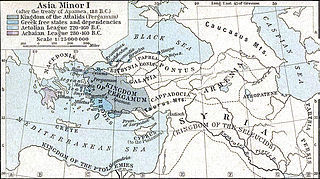
Pergamum at its greatest extent in 188 BCE
December 19, 2014
Christmas in the Trenches
By Juliet Wagner (Regular Contributor)
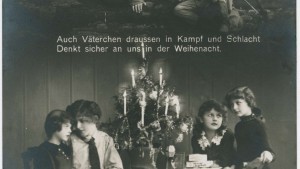
“Little father outside in slaughter and fight surely thinks of us on Christmas night”
Contrary to the confident predictions of August 1914, the war was not over by Christmas. The killing would persist through Christmas 1914—the famous “Christmas Day Truce” on one battlefield in Belgium notwithstanding—and for another three Christmases, before the armistice brought the conflict to an end in November 1918.
The Baden-Württemberg “Haus der Geschichte” (History House) in Stuttgart is currently hosting a wonderful special exhibition on “Das Friedensfest in Kriegszeiten” (The Festival of Peace in Times of War), to accompany its larger exhibition, “Fastnacht der Hölle” (Carnival of Hell), on the First World War and the senses. The special exhibition, which runs until January 11, 2015, is presented in the form of an advent calendar, with 24 display boxes arranged in rows, each showcasing a different artifact or document relating to Christmas and the First World War in the Baden and Württemberg armies. It is also broadly chronological and emphasizes the increasing tensions and fatigue as the war progressed. The sentimental postcards produced for Christmas 1914, depicting divided but optimistic families, already struck a naïve note a year later.
One of the most touching displays (#3) contains a child’s drawing of Christmas trees, peppered with shrapnel holes. The drawing belonged to Reserve Lieutenant Karl August Zwiffelhoffer, who received an “unexpected Christmas vacation” in November 1916 in order to attend his uncle’s funeral. He took this picture, drawn by his four-year-old daughter, Annie, back to the front with him. It was folded in the breast pocket of his jacket when he was killed by shrapnel on May 4, 2017, in the bloody ‘Chemin des Dames’ offensive. Although his effects were returned to his widow, she could not bring herself to open the box in which they were delivered, and the uniform jacket and its contents were not discovered until Annie moved to an old people’s home decades later and her daughter went through her belongings.
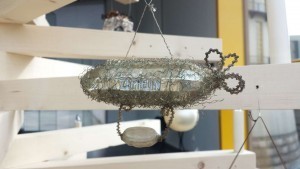 Other display cases contain: orders of service from battlefield worship; children’s Christmas wish lists, requesting cigars (presumably to send to the troops); Christmas postcard advertisements for Bahlsen cookies; a haunting acquatint etching of a Stuttgart soup kitchen at Christmas by the artist Reinhold Nägele; Steiff soldier dolls; home-drawn Christmas cards, depicting life on the home front; and military Christmas ornaments, like this Zeppelin Christmas tree decoration.
Other display cases contain: orders of service from battlefield worship; children’s Christmas wish lists, requesting cigars (presumably to send to the troops); Christmas postcard advertisements for Bahlsen cookies; a haunting acquatint etching of a Stuttgart soup kitchen at Christmas by the artist Reinhold Nägele; Steiff soldier dolls; home-drawn Christmas cards, depicting life on the home front; and military Christmas ornaments, like this Zeppelin Christmas tree decoration.
Additional Resources:
A brief video of the special exhibit by local region tv is available on their website (commentary in German): http://www.regio-tv.de/video/343043.html
There is a slide-show of selected artifacts on the SWR website:
For more information on visiting the exhibition (open Tuesday-Sunday, until January 11, 2015), see: http://www.krieg-und-sinne.de/besucher/
Entry to the exhibition (including the special Christmas side-exhibit described here) costs 3 Euros for adults, and the Haus der Geschichte is walking distance from the main Stuttgart train station. The special exhibition alone is worth the walk and the entrance fee.
December 18, 2014
12 Days: Christmas…A Roman Holiday
By Caroline Lawrence (Wonders & Marvels contributor)
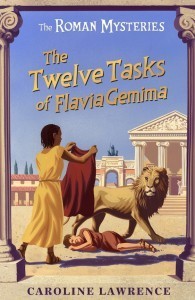 When I was researching my sixth Roman Mystery, set during the mid-winter festival called the Saturnalia, I was amazed by how many ancient Roman customs have survived, embedded in our Christmas celebrations. Here are twelve!
When I was researching my sixth Roman Mystery, set during the mid-winter festival called the Saturnalia, I was amazed by how many ancient Roman customs have survived, embedded in our Christmas celebrations. Here are twelve!
1. Five day vacation. In the first century AD the Romans set aside five days holiday to celebrate the festival of the Saturnalia, a mid-winter pagan festival to bring back the sun. We take approximately the same number of days off for Christmas.
2. December 25th. Romans sacrificed to Saturn but by the first century some were celebrating the birth of an eastern god of light on the 25th of December. No, not Jesus: Mithras! His rites and rituals shared many similarities with our Christian ceremonies. There was a baptism, a sacramental meal, an observance of Sunday, and the god himself was born on the 25th of December
3. Christmas tree, mistletoe, wreaths, etc. Romans decorated their houses with greenery. As Sheldon from Big Bang Theory says, “In the pre-Christian era, as the winter solstice approached and the plants died, pagans brought evergreen boughs into their homes as an act of sympathetic magic, intended to guard the life essences of the plants until spring. This custom was later appropriated by Northern Europeans and eventually became the so-called Christmas tree.”
4. Lights & candles. Romans also decorated their houses with extra lights at this darkest time of the year. Again, this was a pagan attempt to bring back the sun. Torches, tapers, candleabra and oil-lamps flickered throughout the houses of the rich. Because of this Rome was a particular fire hazard in the winter. One historian estimates that a hundred fires broke out daily in the Eternal City, which had its own entire corps of firemen, the vigiles.
5. Feasting! In mid-winter instinct tells us to build up a nice layer of fat, to feast in preparation for lean times ahead. A bit like a bear before hibernation. Yum. Carbohydrates are on the menu again.
6. Drinking. It has been medically proven that a small amount of wine added to water will kill off most known bacteria. For most of the year Romans drank diluted wine, but during the Saturnalia they often drank neat wine, heated and spiced. That’s my excuse for a glass of mulled wine: it’s hygienic.
7. Partying & Role Reversal. For the five days of the Saturnalia, slaves didn’t have to work. They could eat, drink and be merry. Some masters let their slave switch roles. Others, like Pliny the Younger, just left them alone to get on with it. Today, office employees find Christmas the time when they are tempted to take the most liberty. Be careful. Once the Saturnalia is over, you have to go back to being a slave… er, employee.
8. Board games and/or cards. In first century Rome, the only time gambling was legally permitted was during the Saturnalia. Even children and slaves could roll dice for nuts or money without fear of punishment. In the West, Christmas is the only time many families play board games or cards.
9. Party pieces. On the first night of the Saturnalia many households threw dice to determine who would be the King of the Saturnalia. The “King” could command people to do things like prepare a banquet, sing a song, or run an errand. Today we often perform party pieces at our Christmas parties, but Mom usually gets landed with preparing the banquet.
10. Santa hats. Many Roman citizens wore the hats traditionally given to slaves when they were set free. The pileus or pileum – both forms are attested – showed that freeborn Roman citizens were “extra free” from the usual restrictions and laws. These “freedom caps” were conical in shape and made of colourful felt, perhaps fur-trimmed in the winter. Hmmm. A red felt conical hat trimmed with white fur. Remind you of anything?
11. Presents! The Romans gave gifts on the Saturnalia, especially small clay or wooden figures – sigillum singular, sigilla plural – often with moveable joints. Action figures, LEGO and Barbies are our modern equivalent!
12. Gift tags. Finally, Romans often composed two-line epigrams to accompany their Saturnalia gift. So come on all you NaNoWriMo graduates and would-be writers: try composing your gift tags as a two line poem!
Caroline Lawrence has been writing detective stories about first century Rome and the Wild West for over a dozen years. Her passion for plotting combined with an obession with historical accuracy means her history-mystery stories are popular with children, parents and teachers. Here she is at a Christmas booksigning, wearing her pileum or freedom cap.
This post was first published on Wonders & Marvels in December 2012.
December 16, 2014
No Appetite for War
By Alexander Watson (Guest Contributor)
“Every day now brings turnips, turnips and still more turnips.” The hunger felt across Central Europe during the First World War is barely remembered today, but for millions of German and Austro-Hungarian civilians, as for the Hamburg girl who wrote those words in January 1917, it was the conflict’s defining experience. A desperate search for food dominated wartime life. Malnutrition and, in some places, starvation had killed around a million people in Central and Eastern Europe by the end of 1918.

People queue in front of a “goulash gun”. The deployment of these mobile field kitchens onto the streets of Germany was one method by which the government tried to rationalize the feeding of the population. Each contained around 1,400 portions of stew.
The food shortages were partly a consequence of mobilisation for “total war”. By 1915, the drafting of hundreds of thousands of farm workers and horses to the army, soil exhaustion and bureaucratic inefficiency had precipitated crises in production and distribution. Yet the shortages were also engineered deliberately by the ring of enemies surrounding Germany and Austria-Hungary. Britain used its naval supremacy and diplomatic clout ruthlessly to halt imports to Central Europe. The Royal Navy closed the entire North Sea to international trade. What could not be blocked was purchased: Norway’s herring catch, for example, was cornered by the British and then left to rot, solely to deny it to hungry Germans.
The Central Powers struggled to overcome dearth. Officials slowly tried to centralise food management and experimented with rationing and mass soup kitchens. More darkly, occupied territories’ food stocks were callously seized. Society mobilised to search for substitutes. At universities, historians scoured dusty manuscripts to discover what people had eaten in earlier famines. Chemists tried to extract oils from grape and poppy seeds. Private business also strove to fill gaps in the markets. In all, 11,000 so-called “Ersatz” (replacement) foods were produced. Most ranged from the unappealing, through disgusting to actually poisonous. For example, in the absence of flour, wartime sausages could legally be filled with 70 per cent water, becoming squidgy tubes of slime. Walnut shells, plum stones and even turnip heads went into wartime coffee, and dishonest traders mixed sawdust into bread and marketed ash as pepper substitute.

“Citizens’ Cooking Recipe”. A satirical German postcard from 1917 explaining how to make a meal solely from ration coupons unredeemed because the food was unavailable: “Take the meat ration card, coat it in the egg ration card and fry nicely brown with the butter card …”
The unappetising and inadequate diet had disastrous consequences for Germany and Austria-Hungary. Hunger eroded popular support for the conflict. It also delegitimised governments incapable of feeding their peoples. In both states, malnourished citizens rose up at the war’s end in revolution. Worse, the obsession with food security provoked by the trauma would contribute to even greater horrors a quarter of a century later. The Nazis’ genocidal ambitions to annex agricultural “living space” in the east would be motivated not just by vicious racial ideology but also – with the memory of the First World War still strong – by determination to make Germany, as Hitler himself put it, “the most blockade-proof place in the world.”
 Alexander Watson is Lecturer in History at Goldsmiths, University of London. His new book, Ring of Steel: Germany and Austria-Hungary in World War I, has just been published by Basic Books.
Alexander Watson is Lecturer in History at Goldsmiths, University of London. His new book, Ring of Steel: Germany and Austria-Hungary in World War I, has just been published by Basic Books.
W&M is excited to have two (2) copies ofRing of Steel: Germany and Austria-Hungary in World War I for this month’s giveaway! Be sure to enter below by 11:00pm EST on September 30 to qualify (your entry includes a subscription to W&M Monthly).
Please note that, at this time, we can only ship within the US.
Monthly Book Giveaways
* indicates required
Email Address *
First Name
December Book Giveaways
Paul Strohm, “Chaucer’s Tale:1386 and the Road to Canterbury”
Alexander Watson, “Ring of Steel: Germany and Austria-Hungary in World War I”
December 15, 2014
Kale of the Sea: The History and Future of Seaweed
By Gastropod (Regular Contributor)
Call off the search for the new kale: we’ve found it, and it’s called kelp!
In this episode of Gastropod, we explore the science behind the new wave of seaweed farms springing up off the New England coast, and discover seaweed’s starring role in the peopling of the Americas.
The story of seaweed will take us from a medicine hut in southern Chile to a high-tech seaweed nursery in Stamford, Connecticut, and from biofuels to beer, as we discover the surprising history and bright future of marine vegetables. Along the way, we uncover the role kelp can play in supporting U.S. fishermen, cleaning up coastal waters, and even helping make salmon farms more sustainable.

“Irish Distress: gathering seaweed for food on the coast of Clare,” from the Illustrated London News, May 12, 1883.
As a wild food, foraged from the rock cliffs and littoral strand of the world’s coastlines, seaweed has been an important food, fuel, and fertilizer since ancient times. In Japan, seaweed was such an crucial part of the diet that legislation in AD 703 confirmed the right of the Japanese to pay their taxes to the Emperor in kelp form. According to Scottish kelp scientist Iona Campbell, traces of it have been found in Orkney island cremation sites dating back to the Bronze Age. Even further back in history, archaeozoologist Ingrid Mainland has confirmed that the use of seaweed as a fodder for sheep in the Orkneys, which still continues today, dates to the Neolithic period, roughly 5,000 years ago.
Surprisingly, scientists have found even older seaweed remains in the Americas, from 12,500 years ago. Five chewed cuds of Gigartina, a red seaweed, mixed with Boldo leaves, a medicinal herb and mild hallucinogen, were found on the floor of a medicine hut at Monte Verde, Chile—one of the oldest human habitation sites in the Americas. In the episode, Jack Rossen, the archaeobotanist who excavated the site’s fragile plant remains using dental picks, explained how the site’s age and location, combined with the four different species of seaweed found in the medicine hut and in residential areas, led to the development of an entirely new theory to explain how humans arrived in North America.
Rossen also pointed out that the Monte Verde findings led to a re-evaluation of the importance of plants in the diet of hunter-gatherers—and thus also of the role of women in those early human communities.
We’ve always had the stereotype of early people being hunters, big-game hunters. And now we’re thinking more that plants would have been a much more reliable resource; they just didn’t get preserved as well at most sites. And maybe archaeologists, when archaeology was dominated by men, just liked the idea of being big tough hunters, instead of wimpy plant gatherers.
As it turns out, women have also played a pivotal role in transforming kelp from wild to farmed food. Basic seaweed cultivation techniques began to be developed in Japan beginning in the mid-seventeenth century. But, despite becoming a staple food of the Japanese, the basic biology of edible seaweed species remained almost completely unknown until two centuries later, when pioneering British scientist Kathleen Drew-Baker saved the country’s nori farming industry.

D. J. King’s crew haul up the kelp line, attached to a buoy. Photo Nicola Twilley.
In 1948, a series of typhoons combined with increased pollution in coastal waters had led to a complete collapse in Japanese nori production. And because almost nothing was known about its life cycle, no one could figure out how to grow new plants from scratch to repopulate the depleted seaweed beds. The country’s nori industry ground to a halt, and many farmers lost their livelihoods.
Meanwhile, back in Manchester, Dr. Drew-Baker was studying laver, the Welsh equivalent to nori. In 1949, she published a paper in Nature outlining her discovery that a tiny algae known as Conchocelis was actually a baby nori or laver, rather than an entirely separate species, as had previously been thought. After reading her research, Japanese scientists quickly developed methods to artificially seed these tiny spores onto strings, and they rebuilt the entire nori industry along the lines under which it still operates today. Although she’s almost unknown in the U.K., Dr. Drew-Baker is known as the “Mother of the Sea” in Japan, and a special “Drew” festival is still held in her honor in Osaka every April 14.

Charles Yarish’s seaweed nursery. Photo by Nicola Twilley.
In the United States, Charles Yarish should probably be called the “Father of the Sea.” The University of Connecticut marine biologist has spent the past forty years studying the biology of seaweeds, and then applying his research to develop revolutionary new techniques for growing seaweed off the coast of North America. His innovations have helped make make kelp an economically viable crop for the fishermen and shellfish farmers of New England, whose livelihoods have been threatened by a combination of over-fishing, pollution, and warming waters.
Listen to this episode of Gastropod for a visit to Yarish’s lab to learn what he accomplished, and how seaweed farms can help soak up pollution from aquaculture, such as salmon farming, as well as from agricultural run-off and sewage. You’ll also hear how seaweed is something of a superfood; research in China has even demonstrated that it contains compounds that lower cholesterol and blood glucose levels in mice. Now the only remaining challenge is to convince Americans to eat it: Gastropod visits chef Elaine Cwynar‘s kitchen at Johnson & Wales University to sample creative new recipes.
Gastropod, a new podcast hosted by award-winning science journalist Cynthia Graber and Edible Geography-author Nicola Twilley.



